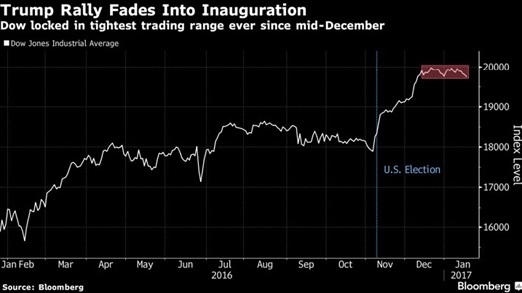MARKETS PAUSE IN SEARCH FOR CLARITY
A new presidential era began last Friday with Donald Trump’s inauguration, and the market reaction was far more restrained than its response to his election. For weeks after the presidential election, we saw markets defy expectations and post significant gains. In fact, the Dow grew by over 1,500 points between November 8 and December 12.[1]
In the four days of trading last week, major U.S. indexes continued the sideways performance we’ve seen since December. For the week, the S&P 500 was down 0.15%, the Dow lost 0.29%, and the NASDAQ gave back 0.34%.[2]
International stocks in the MSCI EAFE also declined by 0.48%.[3]
Despite these weekly losses, Friday’s market performance marked one milestone not seen since John F. Kennedy’s election: index gains on inauguration day.[4] Nonetheless, we still see a market that has been in a holding pattern for weeks. The S&P 500 has barely moved since the day before the Fed raised rates on December 14.[5] And if you analyze this graph of the Dow’s performance, you see a similar scenario. The index grew sharply after the election, but the red box shows performance stalling since December.

The markets are incredibly complex and multifaceted, so one answer cannot fully explain their performance. However, after rallying in anticipation of Trump’s promises for lower taxes, decreased regulation, and increased government spending, investors are now waiting to see which policies will come to fruition.[6]
No one knows for sure what policy changes or political developments lay ahead. We must look closely at fundamentals to see beyond the headlines and find a clearer view of where the U.S. economy stands today.
What are the fundamentals telling us?
During the current corporate earnings season, 63 companies have reported their fourth-quarter results so far. Of these companies, 63% beat earnings-per-share estimates and 46% exceeded their sales estimates.[7]
Last week, we also saw:
The Consumer Price Index increase by 0.3% for December[8]
Industrial production increase by 0.8% for December, erasing its November decline[9]
Housing starts rebound by 11.3% for December after dropping 39.4% in November[10]
This week, three factors will give us a deeper view of economic performance: 1) fourth-quarter GDP reports, 2) consumer sentiment data, and 3) home sales figures. By analyzing data rather than focusing on hype and predictions, we remain committed to your long-term financial health.
What should you focus on?
No matter your political perspectives, moments of change can elicit emotional reactions from even the most rational investors. As always, emotions have no place in investing.
Consider this: After former President Barack Obama’s election in 2008, the S&P 500 dropped 15.5% by inauguration day, as his transition period coincided with the deepening financial crisis.[11] Investors who allowed emotions to take over at that point and left the markets could have missed the S&P 500’s 12% average annual growth each year Obama was in office.[12]
We believe now is the time to continue focusing on your unique risk tolerance, your long-term goals, and the economic fundamentals, not who is in office.
We will continue to monitor economic and market evolution as it occurs, and we will closely watch the political division that seems to grip our country. In the meantime, we are here to answer any questions you may have and help you find the clarity you need.
ECONOMIC CALENDAR:
Tuesday: Existing Home Sales
Thursday: New Home Sales, International Trade in Goods
Friday: GDP, Durable Goods Orders, Consumer Sentiment

Notes: All index returns exclude reinvested dividends, and the 5-year and 10-year returns are annualized. Sources: Yahoo! Finance, S&P Dow Jones Indices and Treasury.gov. International performance is represented by the MSCI EAFE Index. Corporate bond performance is represented by the SPUSCIG. Past performance is no guarantee of future results. Indices are unmanaged and cannot be invested into directly.
These are the views of Platinum Advisor Marketing Strategies, LLC, and not necessarily those of the named representative, Broker dealer or Investment Advisor, and should not be construed as investment advice. Neither the named representative nor the named Broker dealer or Investment Advisor gives tax or legal advice. All information is believed to be from reliable sources; however, we make no representation as to its completeness or accuracy. Please consult your financial advisor for further information.
Investing involves risk including the potential loss of principal. No investment strategy can guarantee a profit or protect against loss in periods of declining values.
Diversification does not guarantee profit nor is it guaranteed to protect assets.
International investing involves special risks such as currency fluctuation and political instability and may not be suitable for all investors.
The Standard & Poor’s 500 (S&P 500) is an unmanaged group of securities considered to be representative of the stock market in general.
The Dow Jones Industrial Average is a price-weighted average of 30 significant stocks traded on the New York Stock Exchange and the NASDAQ. The DJIA was invented by Charles Dow back in 1896.
The Nasdaq Composite is an index of the common stocks and similar securities listed on the NASDAQ stock market and is considered a broad indicator of the performance of stocks of technology companies and growth companies.
The MSCI EAFE Index was created by Morgan Stanley Capital International (MSCI) that serves as a benchmark of the performance in major international equity markets as represented by 21 major MSCI indexes from Europe, Australia and Southeast Asia.
The Dow Jones Corporate Bond Index is a 96-bond index designed to represent the market performance, on a total-return basis, of investment-grade bonds issued by leading U.S. companies. Bonds are equally weighted by maturity cell, industry sector, and the overall index.
The S&P US Investment Grade Corporate Bond Index contains US- and foreign issued investment grade corporate bonds denominated in US dollars. The SPUSCIG launched on April 9, 2013. All information for an index prior to its launch date is back teased, based on the methodology that was in effect on the launch date. Back-tested performance, which is hypothetical and not actual performance, is subject to inherent limitations because it reflects application of an Index methodology and selection of index constituents in hindsight. No theoretical approach can take into account all of the factors in the markets in general and the impact of decisions that might have been made during the actual operation of an index. Actual returns may differ from, and be lower than, back tested returns.
The S&P/Case-Shiller Home Price Indices are the leading measures of U.S. residential real estate prices, tracking changes in the value of residential real estate. The index is made up of measures of real estate prices in 20 cities and weighted to produce the index.
The 10-year Treasury Note represents debt owed by the United States Treasury to the public. Since the U.S. Government is seen as a risk-free borrower, investors use the 10-year Treasury Note as a benchmark for the long-term bond market.
Google Finance is the source for any reference to the performance of an index between two specific periods.
Opinions expressed are subject to change without notice and are not intended as investment advice or to predict future performance.
Past performance does not guarantee future results.
You cannot invest directly in an index.
Consult your financial professional before making any investment decision.
Fixed income investments are subject to various risks including changes in interest rates, credit quality, inflation risk, market valuations, prepayments, corporate events, tax ramifications and other factors.
By clicking on these links, you will leave our server, as they are located on another server. We have not independently verified the information available through this link. The link is provided to you as a matter of interest. Please click on the links below to leave and proceed to the selected site.
- http://fortune.com
- http://finance.yahoo.com
http://finance.yahoo.com
http://finance.yahoo.com - https://www.msci.com
- http://finance.yahoo.com
- https://www.bloomberg.com
- http://www.cnbc.com/
- http://www.pacificglobal.us
- http://www.ftportfolios.com/
- http://www.ftportfolios.com/
- http://www.ftportfolios.com/
- http://finance.yahoo.com
- http://fortune.com








